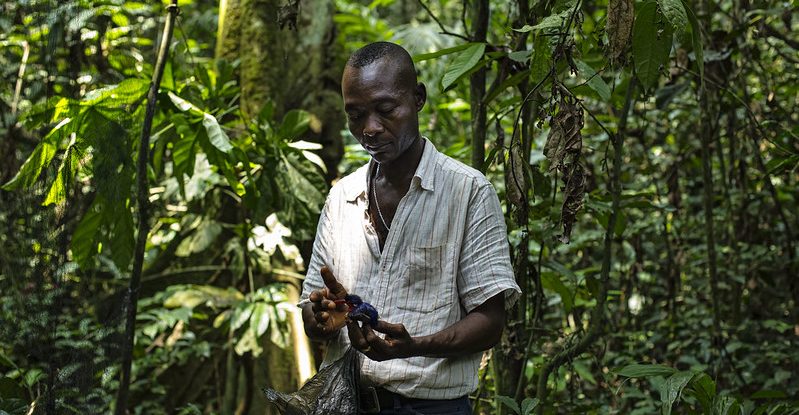
Loss of forest biodiversity can be stopped without disrupting livelihoods – if actions are taken to halt and reverse deforestation, combat illegal and unregulated forest activities and prevent the conversion of natural forests into forest plantations, say experts.
Speakers during the 26th Session of the Committee on Forestry (COFO26) also called on concerted efforts to recognize forest tenure rights of Indigenous Peoples and local communities as an effective strategy to combat illegal forest activities, especially where local communities are the de facto forest managers.
The Food and Agriculture Organization (FAO) and the Center for International Forestry Research (CIFOR), released a comprehensive study on biodiversity mainstreaming in forestry, providing an assessment of good practices and solutions that balance conservation and the sustainable use of forest biodiversity.
“We have increasing demand for wood, and the balance between meeting this demand while maintaining forests – which harbour most of the Earth’s terrestrial biodiversity – is critical,” said Robert Nasi, Director General of CIFOR. “This is possible with a proper legal environment, as well as the involvement of the indigenous communities who draw their livelihoods from the forests.
He underlined the importance of biodiversity in non protected forests and showed that “Well-managed forests can support biodiversity while generating income”.
The study launched at the sidelines of the COFO 26 titled ‘Mainstreaming biodiversity in forestry,” was initiated at the occasion of the Global Landscapes Forum (GLF) Biodiversity Digital Conference: One World – One Health held on 28 October 2020, thanks to the concerted efforts of the CGIAR Research program on Forests, Trees and Agroforestry (FTA) and FAO. It explores the process of embedding – or “mainstreaming” – biodiversity considerations into policies, strategies and practices of key public and private actors to promote conservation and sustainable use of natural resources.
CIFOR -ICRAF Director of Platforms and Programs formerly Director of FTA Vincent Gitz said that generating and sharing knowledge on forest biodiversity is critical in addressing the threats to biodiversity.
“Mainstreaming biodiversity in forest management requires more knowledge on the base line for management, including how to measure impacts. All forest users need awareness on the importance of biodiversity, the impact of what they are doing on biodiversity in a simple way, and the care and knowing what they can do to preserve forest biodiversity,” Mr Gitz said.
The study confirms that deforestation is the single most important driver of forest biodiversity loss, with approximately 10 million hectares of forest cleared for other land uses every year, mainly for conversion to agriculture.
The study also examined other threats to forests and biodiversity, such as disturbances that do not necessarily result in deforestation, but which nevertheless have devastating impacts on the health and vitality of forests – and subsequently their ability to provide a full range of goods and ecosystem services.
“For example, in 2015, insects, diseases and severe weather events damaged about 40 million hectares of forests. Another 98 million hectares were affected by fire in 2015, primarily in the tropics,” the study cites.
Complicated and poorly harmonized systems of laws and regulations, especially those with unclear and conflicting institutional roles, can contribute to the prevalence of illegal activities, among other issues. High levels of corruption and weak law enforcement have also increased illegal use of forest and disrupted biodiversity.
Prioritizing forest policies, plans, programmes, projects and investments that have a positive impact on biodiversity at the ecosystem, species and genetic levels, as well as how to integrate biodiversity concerns into everyday forest management and practices, was one of the key focus of the study.
Case studies were conducted in eight countries: the Democratic Republic of the Congo, Ethiopia, Finland, Japan, Malaysia, Mexico, Peru and the United Kingdom. They allowed to identify success factors and assess progress made on mainstreaming biodiversity in the forest sector in a variety of national contexts.
FAO Senior Forestry Officer Thomas Hofer said the rate at which forests were being destroyed calls for a balance between conservation goals and the satisfaction of human needs.
“We hope that the wealth of information and recommendations provided in this study will inspire actions from those involved in forest management and conservation. The launch of this publication is the beginning, not the end, of forest biodiversity management,” Dr Hofer said during the launch.
We want you to share Forests News content, which is licensed under Creative Commons Attribution-NonCommercial-ShareAlike 4.0 International (CC BY-NC-SA 4.0). This means you are free to redistribute our material for non-commercial purposes. All we ask is that you give Forests News appropriate credit and link to the original Forests News content, indicate if changes were made, and distribute your contributions under the same Creative Commons license. You must notify Forests News if you repost, reprint or reuse our materials by contacting forestsnews@cifor-icraf.org.